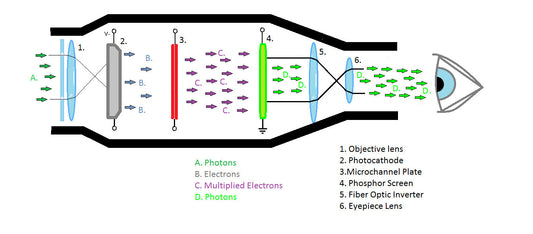Gen.2 – that is the result of improvements in image-intensifier tubes developed through the 1980-s and it is widely used for the tactical and professional surveillance purposes.
There is a biggest gain in Generation 2 like for example the ability to see in extremely low light conditions such as a moonless night, etc. Gen.2 is different to Gen.1 because has different tube engineering which increase the sensitivity due to the addition of the Micro Channel Plate, called MCP or Electron Amplifier, to the image intensifier tube.
The Micro Channel Plate is located between the Multi-Alkaline photocathode and the phosphor screen and looks like a honeycomb where each cell has a large number of channels designed for entering electrons. When the electrons pass microchannels, thousands more electrons are released.
Thanks MCP, which boosts light gain of the image intensifier tube by an approximately a one thousand times, the images are significantly less distorted and brighter and clearer than in the earlier generations of Night Vision Devices.
Depends on resolution and photosensivity there are several variants of Generation 2 on the market, so you can also buy the Generation 2+, which have a higher parameters than Gen.2, and SuperGeneration 2+ based on Gen.2 tube technology, but with further enhanced photocathode sensitivity.
SuperGeneration 2+ with an enhanced photocathode sensitivity up to 600-700+ uA/lm and resolution in the centre varies between 45-60 Ip/mm can really compete with Generation 3, and it is more tolerant of urban lighting than Gen.3 systems.
Gen.3 is currently used by the United States military and provides excellent low light level performance and long tube life. Mil-spec Gen 3 tubes show virtually no distortion and they are limited to strictly military use.
These Night Vision devices use MCP for gain and Gallium Arsenide for the photocathode. Gen.3 devices have a better resolution and sensitivity and can produce a brighter image than Gen.2 but there are still not a substantial changes in the underlying technology. The Gallium Arsenide is very efficient at converting photons to electrons and can produce more than 800 uA/lm in the 450 to 950 nanometer region of the spectrum. The MCP is also coated with a protective ion barrier film to increase tube life.
Gen 3 equipment provides the best results when used in poorly lit environments, such as canyons, forests, or jungles. But if most of your surveillance takes place in urban or nearby areas, then as we mentioned it earlier, Gen.2, Gen.2+ or SuperGen.2+ equipment will be the best solution for you.
Gen.3+ ... to be continued.

